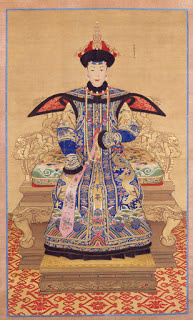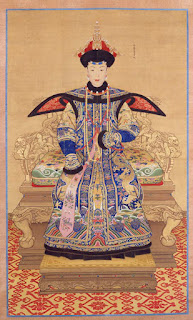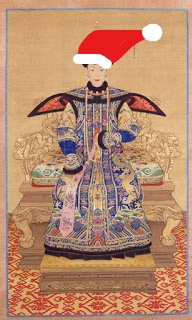
This 15th day coincides with the full moon, in East Asia, believed to be at its brightest and fullest size at this time and coinciding with the traditional harvest time in the midst of Autumn. Mid-Autumn Festival is also known as 'Mooncake Festival,' as Mooncakes, a rich pastry typically filled with sweet-bean or lotus-seed paste are traditionally sold and eaten during this festival. Mooncakes also symbolise togetherness and harmony.
In Vietnam, the Mid-Autumn Festival, "Tết Trung Thu," is the second-most important festival of the year, after the Lunar New Year, or Tet. It's also known as the 'Children's Festival' because of the focus on children - an occasion for a children’s night out, receiving toys as gifts and family reunions. In ancient times, the Vietnamese believed that children, being innocent and pure, had the closest connection to the sacred and natural world. During the festival, parents wanted to make-up for lost time with their children after a long harvest season. Just to confuse matters, in Vietnam, Mid-Autumn Festival is additionally known as 'Lantern Festival,' because of the mass of red and colourful lanterns of all shapes and sizes selling in shops, hung-up in homes and businesses and carried and displayed at this time. The lanterns, mainly red in colour, symbolise beacons to light the way to prosperity and good luck. Traditionally, children parade on the streets to celebrate Mid-Autumn Festival with songs and colourful, shaped lanterns and on streets up and down the country, you'll likely see toys, paper lanterns and other treats like mooncakes on sale, snapped-up by indulgent parents to give to their excited children.

If you happen to be in Ho Chi Minh City during the Mid-Autumn Festival (dates determined each year by the Lunar calendar), the best place to
celebrate and soak-up the fantastic cultural atmosphere is Chinatown, or 'Cholon,' a densely packed area that sprawls across District Five in the city's western fringes. Here, immersed amongst the amiable Viet-Chinese community - the largest in the country - you'll be treated to the most
traditional and vibrant atmosphere and biggest festivities, lasting
around a week or so, extending over the full moon period.
I was unable to attend this year, but experienced this festival in 2020, which was right in the midst of the global pandemic, although you'd never have guessed it, judging by the massive turn-out, what with Ho Chi Minh City's relatively Covid-19 free existence (read a bit about the festival included as an entry in my fascinating Ho Chi Minh City: the Covid-19 diaries Part 1, HERE). True, this was two years ago, but I imagine this festival carries on its traditions and plays out each year without too much variation.
My visit to Chinatown was on the Mid-Autumn Festivals' last official day, which in 2020, fell on October 1st. I soon discovered during the day, the festival - and streets - were a misleading relatively quiet affair, most locals to be found at one of the neighbourhood's stunning Buddhist pagodas and temples for blessings and prayers.
Actually, most of the Mid-Autumn festivities are centred in and around Chinatown's most stunning and oldest temples and pagodas, conveniently clustered together in the far western reaches of Cholon, on and around main artery, Nguyen Trai (read more about Cholon's amazing worshipping sites in my extensive post, My big fat Tet Lunar New Year celebrations in Ho Chi Minh City, HERE.



My visits included Thien Hau Pagoda, (#710 Nguyen Trai Street) - one of Cholon’s most important and oldest pagoda-temples. When Cantonese immigrants founded Hoi Quan Tue Thanh in 1760, they dedicated it to Thien Hau, Goddess Protector of Seafarers, thanking her for safe passage across the South China Sea. Thien Hau is also known as the Women's Pagoda (Chua Ba), as local women
pray to Me Sanh, Goddess of Fertility and Long Mau, Goddess of Mothers and is renowned for its stupendous artwork. The friezes, murals and exquisite glazed ceramic figurines tottering on the decorative roof tops are considered some of Vietnam’s most magnificent.
On many occasions over the years, be it as an intrepid backpacker, guidebook researcher, travel writer and ex-pat, I've been repeatedly spellbound by Thien Hau Pagoda. However, during this Mid-Autumn Festival, I accidentally ended-up with my most memorable experiences (NB: This featured photo was taken years ago, but is arguably one of my better shots.)
One of the rituals devotees undertake at this time - or other auspicious times during the year - is to write a prayer message on a piece of red paper emblazoned with Chinese characters, which is then attached to a large spiral incense coil then hoisted-up in the rafters where it slowly burns. As I understand it - and apologies if I've got this wrong - it is believed that these prayers waft-up to the Heavens riding on the swirling incense smoke.
Seeing all the locals perform this ritual within this temple-pagoda and erring on the spiritual side, I decided to join-in - and if you ever get the chance, I suggest you do the same. I even do a repeat of this prayer ritual at the following year's Tet (Lunar New Year) festivities in another of Cholon's magnificent temple-pagodas, as detailed in that aforementioned post, HERE.
So within Thien Hau, I first went to a side kiosk to pick-up a special red prayer paper and scrawled a personal prayer message on it. Then I was ushered on to another side kiosk to obtain a large spiral incense coil topped with a hook.
A kindly pagoda attendant then helped me attach the red prayer paper to the incense coil. As none of the staff speak a word of English and my Vietnamese is dire, nay, practically non- existent, the entire process was undertaken by pointing, sign-language and guess work - observing what other devotees were doing and following suit.
For privacy reasons, I've redacted my prayer, which is for the Gods and Goddesses eyes only!
I was then 'instructed' to light the incense coil myself, a tricky job, as you've got to manoeuvre the end piece of the delicate incense coil into the candle flame to start the burning process.
Once lit, then another attendant comes swiftly along with a giant hook stick and then hoists the incense coil up to the rafters, where it will slowly burn for eternity, well, hours, perhaps even days, lost amongst the countless others and thick fug of smoke. What price spirituality? True, this isn't free, but costs a paltry VND30,000 (just over one US dollar), which should cover costs of the temple paraphernalia and perhaps even help contribute to the upkeep of the ancient site!



No sooner, had I completed this uplifting (literally) ritual and making an exit out of Thien Hau's main entrance, where, by chance, a duo of lion dancers had just arrived and started performing in the front courtyard. Symbolising good luck, wealth and prosperity, Lion
dances are another significant festival element. The temple-pagoda gatekeeper informed me (in pretty good English) that it was very auspicious to see the lion dances at the pagoda-temple, so I decided to hang around a bit longer, captivated by their antics.
I was surprised when the two lions were then 'led' deep into the temple-pagoda by their assistant, regrouping to continue their blessing ritual at the altar, as customary.
After this lucky sighting, I continued on to visit a couple more pagoda and temples, nearby.....
As the afternoon blurred into evening, while walking along the now neon-lit Nguyen Trai Street, yet again by chance, I encountered more lion dancers, this time part of a noisy and colourful procession, part of the annual festivities - heading along Cholon's main artery.
I attempted to follow the lion dancers in hot pursuit as the procession made its way at a surprisingly fast pace along the crowded streets (explaining why I didn't get many shots and those that I did, appear b-l-u-r-r-y). As darkness falls, this is the time where Cholon's streets really come alive, super-crowded as every year, with locals and families, out to watch the street processions, go shopping for toys and decorative lanterns, admire the hanging lanterns glowing in the dark and grab something to eat.
I discovered the best on-foot circuit - and liveliest section of the festival - is on main street Nguyen Trai Street, then plunging off into atmospheric Luong Nhu Hoc Street, through slender alleyway, Phu Dinh, which leads out to adjoining side-street, Nguyen An, running parallel to Luong Nhu Hoc Street.
Long famed for its lion head masks, atmospheric Luong Nhu Hoc is known as 'Lantern Street,' for decades, specialising in manufacturing and retailing numerous varieties of lanterns and Mid-Autumn toys. The market, established in the 1960s, is well-known for its
artisans who make traditional lanterns from scarlet glass paper, considered a
special cultural trait of the Viet-Chinese community.
During this Festival, Luong Nhu Hoc Street, a stretch of just a few hundred metres and shorter Nguyen An Street come into their element, considered Ho Chi Minh City's largest lantern market, with stalls and many of the shops overflowing onto the pavements displaying hanging lanterns of various sizes, shapes and colours - from paper to glass paper and cellophane - that magically illuminate the streets.
As the Mid-Autumn festival is predominately aimed at children, you'll see all kinds of festive merchandise featuring traditional and modern toys, paper lanterns in a variety of themes and shapes -from fish and stars to butterflies - and more, hanging-up in the many stalls and shops, before they're taken down and sold to wide-eyed little ones.

There's even the odd mobile balloon stall ...
As there were so many locals and visitors, especially families, flocking here during this final night, the bustling side-streets increasingly got jam-packed, with a bottle-neck of pedestrian traffic at a couple of hot-spots; only after civic officials arrived to hastily enforce a one-way system and strategic barriers, did the crowd situation improve somewhat.
And worth pointing out, these massive festival crowds were during the height of the global pandemic in 2020... not much social distancing here, in fact, quite the opposite. Hard to believe numbers were down that year with less than the usual folk attending, including a noticeable absence of international tourists (albeit many don't know this festival even exists), stall holders complaining business was down and a number of reduced festivities..... goodness knows how it is in 'normal' years!
All this makes for hungry work: besides the standard local restaurants and eateries, there's plenty of make-shift stalls cooking-up tasty snacks and treats - anything from Dim Sum to Vietnamese-style pizzas - to keep the masses well-fed.
Squashed-up with a friendly Saigonese couple at a small local eatery spilling out onto the pavements of Nguyen An Street, I enjoyed a plate of dirt-cheap Chinese dumplings and hot tea - and a breather from the crowds. Not speaking the language and unable to read the menu, again, the best way to communicate was just a case of pointing at what looked good to the amiable waiter.
So if you're in Vietnam during autumn time, what better way to immerse yourself in the local traditions and culture, than joining-in with the Mid-Autumn / Lantern / Mooncake / Children's Festival and in Ho Chi Minh City, especially, amid evocative and magical Cholon.


















































Comments
Post a Comment